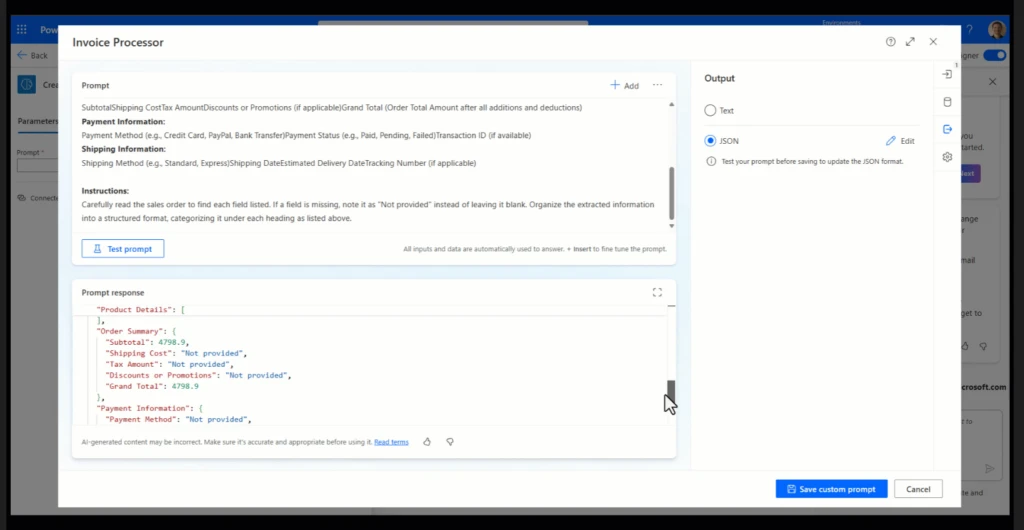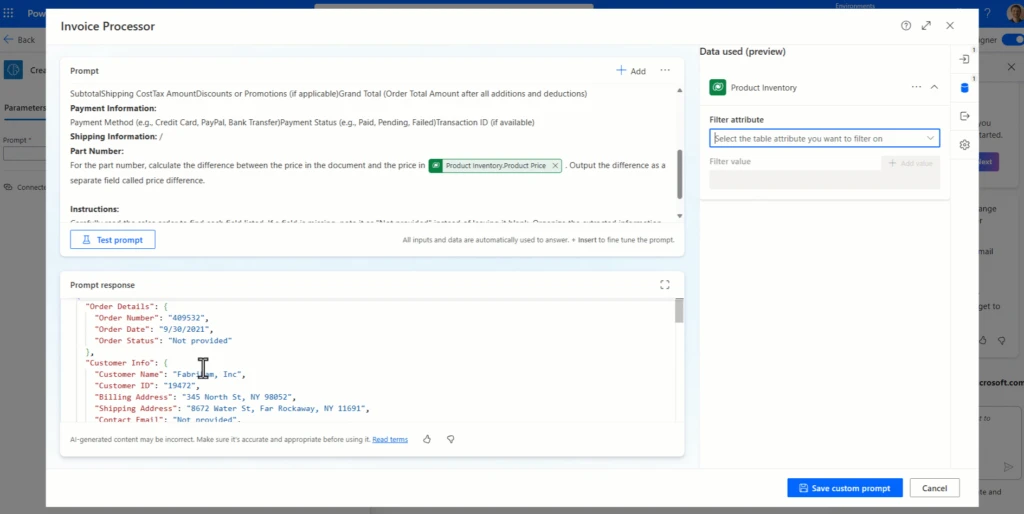
Boost productivity: Automate emails, documents, and images with Microsoft AI Builder
In today’s business environment, streamlined workflows and reduced manual tasks are essential. Microsoft AI Builder brings the power of advanced automation to routine processes like email handling, document processing, and image management, helping businesses run smarter and more efficiently. With new capabilities, including multi-modal content processing, structured JSON outputs, flexible model selection, Dataverse grounding, and an extensive prompt library, AI Builder elevates agents, apps and automation to the next level of business impact.
Next generation document and image processing with GPT
One of the most game-changing updates in AI Builder is the new multi-modal content processing capability, which allows businesses to handle various data types —including text, document, and images—within a single natural language instruction. This integration greatly simplifies the process of crafting AI actions for intelligent document processing. Unlike traditional machine learning models that require extensive training and expertise, AI Builder’s multi-modal processing can be set up using natural language, and without training data.
Structured JSON outputs now generally available
With AI Builder’s new structured JSON output feature, businesses gain a more deterministic and reliable way to handle generated content. Unlike traditional outputs that might vary in format and structure, JSON outputs are now generated with a consistent predefined schema that you define at design time, ensuring that every result aligns precisely with expected data formats. This determinism in content generation means your automated workflows will produce predictable, structured data every time, and those results will be readily integrated as variables in your Power Automate workflow for downstream processing. This feature is especially beneficial when integrating AI Builder outputs into other systems, as it reduces the need for additional data cleaning or transformation. Whether feeding data into a CRM, database, or custom application, you can ensure that data is generated in a structured and predictable way.

Dataverse grounding is now generally available
The new Dataverse grounding capability empowers Generative AI models with up-to-date, contextually relevant information from your organization’s own data. By employing Retrieval-Augmented Generation (RAG), AI Builder integrates directly with Dataverse to pull in real-time, business-specific knowledge, giving models a deeper understanding of your unique context.
This RAG-enhanced approach allows AI models to dynamically retrieve and incorporate relevant data from Dataverse during processing, enabling Q&A scenarios with accurate responses that are also highly contextualized to your organization. For instance, models can instantly access customer histories, product information, and up-to-the-minute operational data, enriching outputs with knowledge directly grounded in your business reality.
As part of this feature becoming generally available, the capability has been enhanced to support multiple tables, including tables with large amounts of data records.

Model selection: GPT-4o and GPT-4o Mini
AI Builder offers flexibility in model selection, allowing users to choose between the powerful GPT-4o and the cost-effective GPT-4o Mini. This adaptability enables customization based on specific project requirements and resource considerations.
Prompt library
The prompt library feature provides a collection of pre-designed prompts, serving as templates to expedite the creation of AI models. This resource accelerates development and ensures best practices are followed in prompt engineering. Users can modify templates to suit specific needs, adjusting language, tone, and detail to match organizational standards and requirements. The templates cover key areas like document extraction, data transformation, and content generation, making it easy for users to find the right starting point for their intelligent automation goals.

Use cases to get started
With AI Builder, you don’t need to be a coding expert to leverage the power of AI in your daily operations. By creating prompts that can extract information from documents, classify emails, and even analyze images, you can empower your team to work smarter, not harder. AI Builder works hand-in-hand with other Power Platform tools like Power Automate, Copilot Studio and Power Apps, enabling users to create intelligent workflows and applications that are customized to meet the needs of any business.
For example, let’s say your team frequently processes customer inquiries. Using AI Builder and Power Automate, you can design a workflow that analyzes the content of incoming emails, categorizes them by urgency or topic, and even suggests responses. This not only saves time but also keeps communication consistent and efficient. By setting up this automated flow, businesses can stay on top of customer interactions and ensure timely responses.
Are you ready to bring AI to your organization?
The AI Builder Documentation provides a comprehensive guide on setting up AI Builder, configuring models, and integrating it with tools like Power Automate and Power Apps.
For step-by-step tutorials, the Microsoft Learn AI Builder Learning Path is an excellent place to start. It covers everything from foundational concepts to advanced use cases, helping users of all levels become proficient in leveraging AI Builder to automate and optimize workflows.
For guidance and samples on using the multi-modal content processing and other prompts with Power Apps, you can use the Creative AI Kit in App Source or GitHub. The new samples that use multi-modal prompts include AI Image Diff, AI Describe Image, AI Fields from Image and AI Generate QnA.
Join our Ignite sessions and read about other exciting announcements for Microsoft Power Platform:
- Automate e-mail, doc, and image processing with GPT in Power Automate with Gwenael Bego and Maria Gutierrez
- Revolutionize the way you work with Power Automate and AI with Joe Fernandez and Heather Orta-Olmo
- Unlock innovation with practical strategies in Power Automate with Jonathan Kendall
- See our Dataverse Ignite session (virtual and in person): Explore Ignite 2024: Unlock enterprise knowledge with Dataverse – Microsoft Power Platform Blog
